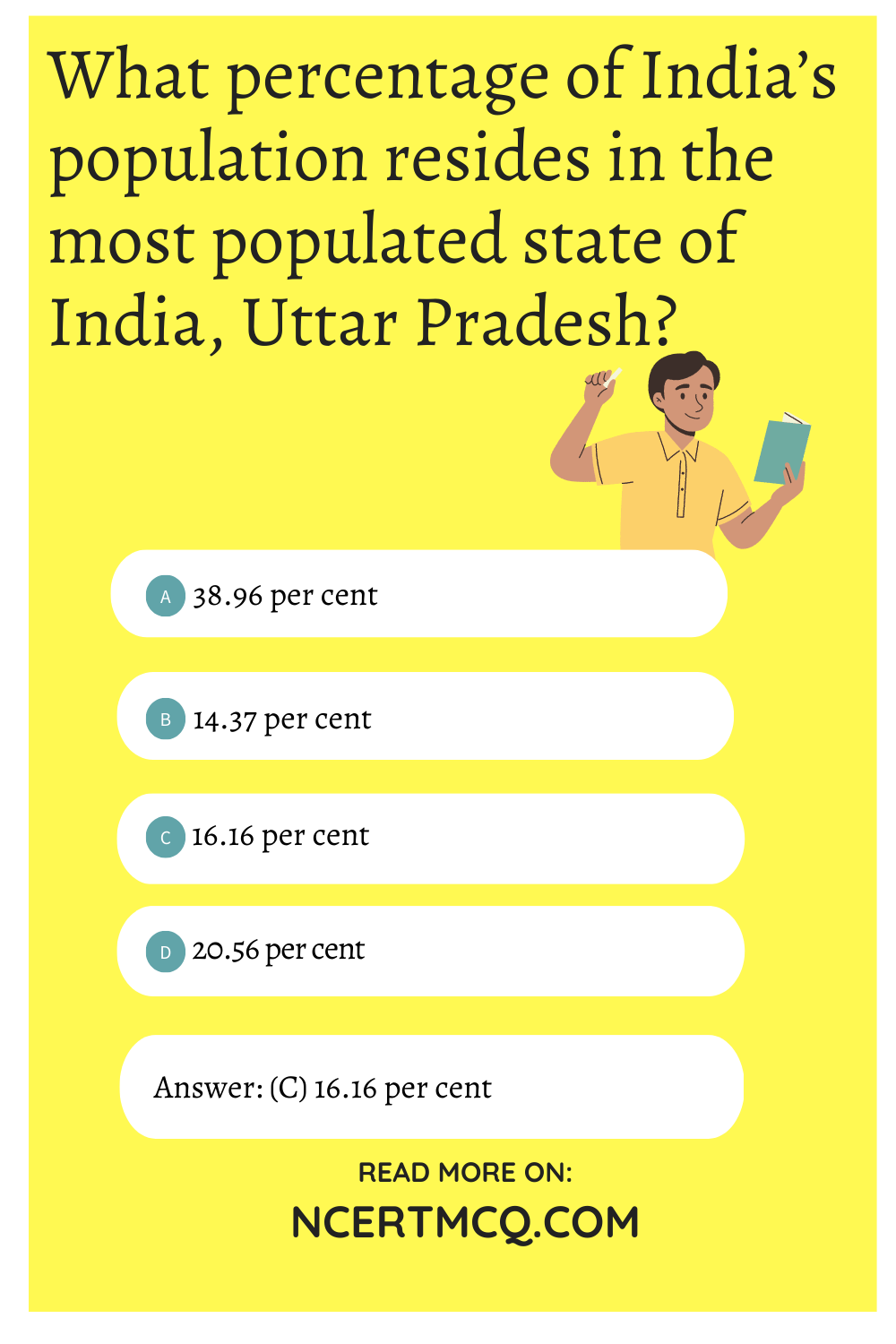Check the below NCERT MCQ Questions for Class 9 Geography Chapter 6 Population with Answers Pdf free download. MCQ Questions for Class 9 Social Science with Answers were prepared based on the latest exam pattern. We have Provided Population Class 9 Geography MCQs Questions with Answers to help students understand the concept very well. https://ncertmcq.com/mcq-questions-for-class-9-social-science-with-answers/
Class 9 Social Science Geography Chapter 6 MCQ With Answers
Geography Class 9 Chapter 6 MCQs On Population
Choose the correct option:
Population Class 9 MCQ Chapter 6 Question 1.
Migrations change the number, distribution and composition of the population in
(a) the area of departure
(b) the area of arrival
(c) both the area of departure and arrival
(d) none of the above
Answer
Answer: (c) both the area of departure and arrival
Class 9 Geography Chapter 6 MCQ With Answers Question 2.
A large proportion of children in a population is a result of
(a) high birth rates
(b) high life expectances
(c) high death rates
(d) more married couples
Answer
Answer: (a) high birth rates
Population MCQ Class 9 Question 3.
The magnitude of population growth refers to
(a) the total population of an area
(b) the number of persons added each year
(c) the rate at which the population increases
(d) the number of females per thousand males
Answer
Answer: (a) the total population of an area
Class 9 Geography Chapter 6 MCQ Question 4.
According to the census 2001, a ‘literate’ persons is one who
(a) can read and write his/her name
(b) can read and write any language
(c) is 7 years old and can read and write any language with understanding
(d) knows the 3‘R’s (readings, writing, arithmetic)
Answer
Answer: (c) is 7 years old and can read and write any language with understanding
Class 9 Population MCQ Chapter 6 Question 5.
Which one of the following country has higher population density than India?
(a) Bangladesh
(b) Nepal
(c) Korea
(d) Canada
Answer
Answer: (a) Bangladesh
Explanation:
Only Bangladesh and Japan have higher average population densities than India. The population density of India in the year 2001 was 324 persons per sq. km.
Population MCQ With Answers Chapter 6 Question 6.
What percentage of India’s population resides in the most populated state of India, Uttar Pradesh?
(a) 38.96 per cent
(b) 14.37 per cent
(c) 16.16 per cent
(d) 20.56 per cent
Answer
Answer: (c) 16.16 per cent
Explanation:
Uttar Pradesh with a population size of 166 million people is the most populous state of India. Uttar Pradesh accounts for about 16 per cent of the Country’s population.

MCQ On Population Geography Chapter 6 Question 7.
Which state has the lowest population in India?
(a) Uttar Pradesh
(b) Himachal Pradesh
(c) Sikkim
(d) All of these
Answer
Answer: (c) Sikkim
Explanation:
On the other hand, the Himalayan state Sikkim has a population of just about 0.5 million and Lakshadweep has only 60 thousand people.
Population Geography MCQ Chapter 6 Question 8.
India accounts for what percentage of the world population?
(a) 16.7 per cent
(b) 20 per cent
(c) 15 per cent
(d) 18.6 per cent
Answer
Answer: (a)16.7 per cent
Explanation:
India’s population as on March 2001 stood at 1,028 million, which account for 16.7 per cent of the world’s population.
MCQs On Population Chapter 6 Question 9.
Which is the point of reference from which all other elements are observed?
(a) Fauna
(b) Population
(c) Flora
(d) All of these
Answer
Answer: (b) Population
Explanation:
Population is the pivotal element in social studies. It is the point of reference from which all other elements are observed.
MCQ On Demography And Census Ncert Chapter 6 Question 10.
Which one of the following state of India has very low population density?
(a) Arunachal Pradesh
(b) Sikkim
(c) Orissa
(d) All of these
Answer
Answer: (a) Arunachal Pradesh
Explanation:
Densities vary from 904 persons per sq km in West Bengal to only 13 persons per sq km in Arunachal Pradesh.
Population Geography MCQ Pdf Chapter 6 Question 11.
What do you mean by the magnitude of population growth?
(a) The total population of an area
(b) The number of females per thousand males
(c) The number of persons added each year
(d) None of these
Answer
Answer: (c) The number of persons added each year
Explanation:
The absolute numbers added each year or decade is the magnitude of increase. It is obtained by simply subtracting the earlier population.
Question 12.
Which one of the following state has a population density below 100 persons per square kilometre?
(a) Jammu and Kashmir
(b) Uttarakhand
(c) Nagaland
(d) All of these
Answer
Answer: (a) Jammu and Kashmir
Explanation:
Jammu and Kashmir has a population density below 100 persons per square kilometre; there was an increase of two persons for every 100 persons in the base population.
Question 13.
Which one of the following state has very high population density in India?
(a) West Bengal
(b) Madhya Pradesh
(c) Rajasthan
(d) All of these
Answer
Answer: (a) West Bengal
Explanation:
Densities vary from 904 persons per sq. km in West Bengal to only 13 persons per sq km in Arunachal Pradesh.
Question 14.
Who is resource creating factors as well as resources themselves?
(a) Animals
(b) Human beings
(c) Plants
(d) All of these
Answer
Answer: (b) Human beings
Explanation:
The people make and use resources and are themselves resources with varying quality. The people are important to develop the economy and society.
Question 15.
In how many years is the official enumeration of population carried out for census?
(a) 5 years
(b) 16 years
(c) 2 years
(d) 10 years
Answer
Answer: (d) 10 years
Explanation:
In every 10 years is the official enumeration of population carried out for census. The census of India provides us with information regarding the population of our country.
Question 16.
What is the average sex ratio of India as per 2001 census?
(a) 956
(b) 973
(c) 933
(d) 945
Answer
Answer: (c) 933
Explanation:
The average sex ratio of India as per 2001 census is 933. Kerala has a sex ratio of 1058 females per 1000 males; Pondicherry has 1001 females for every 1000 males.
Question 17.
Which one of the following state in India has a population density below 250 persons per square km?
(a) Punjab
(b) Haryana
(c) Chhattisgarh
(d) None of these
Answer
Answer: (c) Chhattisgarh
Explanation:
Chhattisgarh is the state with population densities below 250 persons per square km. rugged terrain and unfavourable climatic conditions.
Question 18.
A large proportion of children in a population is a result of:
(a) High death rate
(b) High married rate
(c) High birth rate
(d) None of these
Answer
Answer: (c) High birth rate
Explanation:
High birth rate is the result of a large proportion of children in a population. The percentage of children and the aged affect the dependency ratio because these groups are not producers.

Question 19.
What is the main cause for the high growth of our population?
(a) Rise in death rate
(b) Decline of death rate
(c) Decline of birth rate
(d) None of these
Answer
Answer: (b) Decline of death rate
Explanation:
Death rate is the number of deaths per thousand persons in a year. The main cause of the rate of growth of the Indian population has been the rapid decline in death rates.
We hope the given NCERT MCQ Questions for Class 9 Geography Chapter 6 Population with Answers Pdf free download will help you. If you have any queries regarding Population CBSE Class 9 Geography MCQs Multiple Choice Questions with Answers, drop a comment below and we will get back to you soon.
Class 9 Social Science Geography MCQ:
